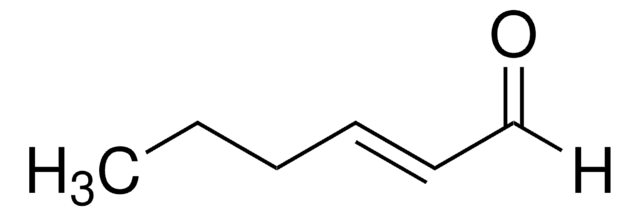W317101
cis-3-Hexenyl acetate
≥98%, stabilized, FCC, FG
Sinónimos:
(3Z)-3-Hexen-1-ol acetate, (3Z)-C-3-Hexenyl acetate, Leaf acetate
About This Item
Productos recomendados
biological source
synthetic
Quality Level
grade
FG
Fragrance grade
Halal
Kosher
agency
follows IFRA guidelines
reg. compliance
EU Regulation 1223/2009
EU Regulation 1334/2008 & 178/2002
FCC
assay
≥98%
contains
α-tocopherol, synthetic as stabilizer
refractive index
n20/D 1.427 (lit.)
bp
75-76 °C/23 mmHg (lit.)
density
0.897 g/mL at 25 °C (lit.)
application(s)
flavors and fragrances
documentation
see Safety & Documentation for available documents
food allergen
no known allergens
fragrance allergen
no known allergens
organoleptic
fresh; green; fruity; sweet
SMILES string
[H]\C(CC)=C(/[H])CCOC(C)=O
InChI
1S/C8H14O2/c1-3-4-5-6-7-10-8(2)9/h4-5H,3,6-7H2,1-2H3/b5-4-
InChI key
NPFVOOAXDOBMCE-PLNGDYQASA-N
¿Está buscando productos similares? Visita Guía de comparación de productos
Categorías relacionadas
General description
Application
- Volatiles from cotton aphid (Aphis gossypii) infested plants attract the natural enemy Hippodamia variegata.: This study explored how volatiles, including cis-3-Hexenyl acetate, emitted by cotton plants infested with Aphis gossypii attract the natural predator Hippodamia variegata, highlighting its potential in biological pest control strategies (Yi et al., 2023).
Biochem/physiol Actions
signalword
Warning
hcodes
Hazard Classifications
Flam. Liq. 3
Storage Class
3 - Flammable liquids
wgk_germany
WGK 2
flash_point_f
134.6 °F
flash_point_c
57 °C
ppe
Eyeshields, Gloves, multi-purpose combination respirator cartridge (US)
Elija entre una de las versiones más recientes:
¿Ya tiene este producto?
Encuentre la documentación para los productos que ha comprado recientemente en la Biblioteca de documentos.
Los clientes también vieron
Nuestro equipo de científicos tiene experiencia en todas las áreas de investigación: Ciencias de la vida, Ciencia de los materiales, Síntesis química, Cromatografía, Analítica y muchas otras.
Póngase en contacto con el Servicio técnico








